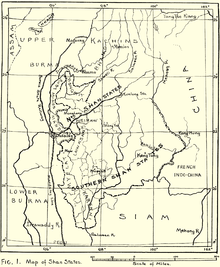Kengcheng or Keng Cheng (also known as Kyaingchaing and Chiang Khaeng) was one of the Shan states. In 1896, part of Keng Cheng was incorporated into the neighbouring state of Kengtung in what is today Burma, and the other part, which is now in Laos, went to French Indochina.[1]
| Kengcheng State | |||||||||||
|---|---|---|---|---|---|---|---|---|---|---|---|
| State of the Shan States | |||||||||||
| 18th century–1896 | |||||||||||
 | |||||||||||
| History | |||||||||||
• Foundation of the state | 18th century | ||||||||||
• Division of the state | 1896 | ||||||||||
| |||||||||||
History edit
Kengcheng was a tributary state of the King of Burma until 1887, when the Shan states submitted to British rule after the fall of the Konbaung dynasty. The capital of Keng Cheng was at Muang Sing (now part of Laos).[2]
In 1896, Kengcheng was divided between British Burma and French Indochina with the Mekong as a border. The districts of the Cis-Mekong part of the state were merged with Kengtung State and the eastern districts, now the Muang Sing area, went first to Siam and then to the French. The limit between Kengtung and China was demarcated by an Anglo-Chinese commission in 1898–1899.[3]
Sir George Scott mentioned the following about the Keng Cheng Myosa:[4]
This was the unfortunate man who was told that he belonged to Siam and then that he didn't. Half his territory finally handed over to France.
Rulers edit
The rulers of Kengcheng had the title Ngwegunhmu and by c. 1880, it changed to Myoza.[5]
- 1372–1422 Sao Deik Nwe
- 1422–1438 Kai Kaew Wak Hpa
- 1438–1446 Sao Krue Maing (son of Kai Kaew Wak Hpa)
- 1446–1472 Sao Hai Khaing (son of Sao Krue Maing)
- 1472–1496 Möng Phrom Maha Inn (son of Sao Hai Khaing)
- 1496–1510 Hkun Muen Hua Pan Na Sai (son of Möng Phrom Maha Inn)
- 1510–1516 Hla Inn Hta (younger brother of Möng Phrom Maha Inn)
- 1516–1527 Hsen Inn Hta (younger brother of Hla Inn Hta)
- 1527–1537 Naw Kaew Phoumma (son of Hla Inn Hta)
- 1537–1555 Thippayajak (son of Hsen Inn Hta)
- 1555–1593 Haw Kham Nwe (son of Naw Kaew Phoumma)
- 1593–1615 Hpaya Hkon Luang (son of Haw Hkam Nwe)
- 1615–1640 Hpaya Waen Jeed Luang (son of Hpaya Hkon Luang)
- 1640–1657 Sao Hkam Mai (son of Hpaya Waen Jeed Luang)
- 1657–1670 Sao Hkam Sai (son of Sao Hkam Mai)
- 1670–1676 Sao Malai (younger brother of Sao Hkam Sai)
- 1676–1709 Hsari Naw Hseng Kaew (son of Sao Hkam Mai)
- 1709–1740 Suwanwongwad (son of Sao Malai)
- 1740–1755 Sao Kam Chai (son of Hsari Naw Hseng Kaew)
- 1755–1771 Sao Inn Torn (son of Sao Kam Chai)
- 1771–1795 Sao Sa Hlaing Ratn (younger brother of Sao Inn Torn)
- 1795–1813 Khattiyawongsa (son of Sao Sa Hlaing Ratn)
- 1813–1849 Hpaya Möng Hkon (son of Khattiyawongsa)
- 1849–1859 Tippani Hkam (son of Hpaya Möng Hkon)
- 1872–1881 Sao Kawng Tai (from Kengtung)
- 1881–1882 Sao Hsiri Naw Hkam (son of Tippani Hkam)
- 1882–1892 Sao Ong Hkam (son of Sao Hsiri Naw Hkam) last saopha
References edit
- ^ Scott, James George; Hardiman, John Percy (1901). Gazetteer of Upper Burma and the Shan States. Vol. 3. AMS Press. ISBN 978-0-404-16860-5.
- ^ Simms, Sanda (2013-10-11). The Kingdoms of Laos. Routledge. ISBN 978-1-136-86330-1.
- ^ "Edward Vaughan Hyde Kenealy". Encyclopedia Britannica. Retrieved 2020-05-31.
- ^ Scott, James George, Sir. 1934. Scott Collection: Views in Keng Tung and the Wild Wa Country.
- ^ "Shan and Karenni States". World Statesmen.org. Retrieved 2020-05-31.
External links edit
- The Tai Of The Shan State
- Keng Cheng
- The Imperial Gazetteer of India
- "WHKMLA : History of the Shan States". 18 May 2010. Retrieved 21 December 2010.